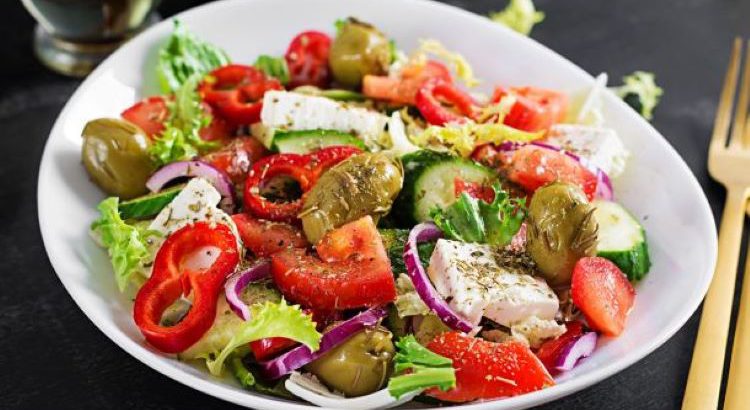Need an excuse to indulge in some hot chocolate? You can thank me later! Chocolate has been consumed as a health food since we started eating. It’s high in antioxidants, flavonoids that help protect your heart, and vitamins and minerals such at magnesium, zinc, potassium, iron and selenium. According to a meta-analysis of 13 studies, consuming chocolate significantly reduced serum triglycerides when compared to a control. Other markers for heart health, such as blood pressure and cholesterol, did not show improved outcomes, but did not show worse outcomes either. So why not eat more chocolate? We typically add lots of fat and sugar to our chocolate. If you’re a chocolate lover, we recommend that you go for 70% cocoa or darker and be mindful of the fat and added sugar!
Author: Carroll

Mediterranean Salad
It’s a new year, and we’re all looking for a fresh (and refreshing) start! Nothing is quite as refreshing as a crispy crunchy cold wedge salad with a healthy twist. Blue cheese dressing is tasty, but it’s typically made with heavy cream and mayonnaise, making it high in saturated fat and not the most physically nourishing choice. This recipe has a Mediterranean alternative, made with heart-healthy olive oil and tahini.
The Mediterranean diet is known for its many health benefits, such as its anti-inflammatory qualities and positive effects regarding heart health and even cognitive well-being. If you’re looking for some easy nutrition guidelines to start 2024, Mediterranean is a good place to go.

Staying Safe in Winter: Tips for Avoiding Slips and Falls
Winter is a season filled with snowy landscapes and chilly weather, but it also brings challenges like slippery sidewalks and icy paths. To ensure safety and prevent falls during this time, it’s important to follow some simple yet effective tips.

Pomegranate Chia Pudding
Chia seeds are a powerhouse of nutrition! They are packed with fiber—with 1g of fiber for every teaspoon—and a good source of healthy fats like omega-3 fatty acids. However, an interesting fact about omega-3 fatty acids is that they come in various forms. AHA, alpha-linolenic acid, is the form found in plant oils and is converted in the body into DHA (docosahexaenoic acid) and EPA (eicosapentaenoic acid), which is then used by the body. Unfortunately, our bodies are not very good at this conversion process, and we must still directly consume foods high in EPA and DHA, such as cold-water fish, fortified foods or certain types of algae. Despite this, chia seeds are still a great addition to your diet; their healthy fats and fiber help you feel full and satisfied. Chia seeds are also high in protein, magnesium, phosphorus, vitamins B1, B3 and zinc.

French Toast Casserole
If you are hosting overnight guests this holiday season, this recipe is a must! You can make this several days ahead of time, it’s packed with nutrition, it’s filling and maintains the sweet holiday spirit. This recipe cuts back on the cream and added sugar, while at the same time uses a whole grain loaf for added fiber, berries for vitamins and minerals, and some Greek yogurt for a protein boost!

Creamy Rutabaga Mash
It’s a carb heavy time of year and, for those who are challenged to maintain their blood sugar within healthy limits, this spells trouble. Not to worry, healthy and delicious alternatives for your holiday favorites abound, including mashed potatoes. The rutabaga is a fantastic, low-carb potato substitute. Anything a potato can do, a rutabaga can do better. French fries? Yes. Hash browns? Yes! Home fries? Definitely! And, of course, a delicious and creamy mash. You can even make a mix of potato and rutabaga if you’re feeling unsure about a complete swap. One cup of potato comes with 113 calories, 26g of carbs and 2.7g of fiber, compared to 1 cup of rutabaga, which has 53 calories, 12g of carbs and 3.2g fiber. The roasted garlic and fresh thyme add incredible flavor to the dish. This may be your new holiday favorite!

Crispy Air Fried Latkes and Applesauce
Just about every culture that has access to potatoes has some variation of a crispy fried potato cake. Of all the delicious potato cakes around the globe, it’s hard to choose a recipe. However, for potatoes, ‘tis the season for latkes! This recipe utilizes an air fryer, cutting back on excess grease but maintaining the crispy goodness. Latkes are traditionally paired with applesauce, which is incredibly simple to make, and sour cream. Now, if you’re looking to add even more nutrition to this dish, you have to be willing to tamper with the original recipe. Using a 50/50 blend of potato with another veggie such as parsnip or zucchini will add in more fiber, nutrients and cut the carbs for those who need to watch their intake. In addition, replacing sour cream with a 2% plain Greek yogurt will give added protein to balance out the carb-y potato. If you’re hesitant about the transition to Greek yogurt, try full fat first— it’s still lower in fat than sour cream. For 2 tablespoons, Greek yogurt has 1g of fat and sour cream has 5g. They taste the same, I promise!

Massage and Pregnancy
Perinatal massage is therapeutic bodywork that supports you as your body goes through the many changes of pregnancy. From physical to emotional symptoms, a massage from a specially trained massage therapist can help alleviate multiple symptoms as well as produce an overall sense of relaxation and well-being.

Turkey Soup
Looking for something to do with leftover turkey? Making a soup is a great way extract all the nutritional goodies out of that bird, leaving you with a soup base that is deeply nourishing both for the body and soul! When you make a broth from the turkey carcass, you’ll be getting nutrients such as collagen, an important component for maintaining the health of your skin, tendons and other connective tissues, along with vitamin A, vitamin K2, zinc, calcium, manganese and selenium. If it’s too soon for more turkey, this soup can keep in the freezer for 3 months.

November is National Diabetes Month
Diabetes is a disease that occurs when an individual’s blood glucose, also called blood sugar, is too high. It affects 37 million Americans, including adults and children. When diabetes is not managed properly, it can damage eyes, kidneys, nerves and heart, and it is linked to some types of cancer.
